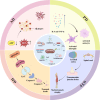Inherent potential of mitochondria-targeted interventions for chronic neurodegenerative diseases
- PMID: 40313114
- PMCID: PMC12407529
- DOI: 10.4103/NRR.NRR-D-24-01507
Inherent potential of mitochondria-targeted interventions for chronic neurodegenerative diseases
Abstract
The cure rate for chronic neurodegenerative diseases remains low, creating an urgent need for improved intervention methods. Recent studies have shown that enhancing mitochondrial function can mitigate the effects of these diseases. This paper comprehensively reviews the relationship between mitochondrial dysfunction and chronic neurodegenerative diseases, aiming to uncover the potential use of targeted mitochondrial interventions as viable therapeutic options. We detail five targeted mitochondrial intervention strategies for chronic neurodegenerative diseases that act by promoting mitophagy, inhibiting mitochondrial fission, enhancing mitochondrial biogenesis, applying mitochondria-targeting antioxidants, and transplanting mitochondria. Each method has unique advantages and potential limitations, making them suitable for various therapeutic situations. Therapies that promote mitophagy or inhibit mitochondrial fission could be particularly effective in slowing disease progression, especially in the early stages. In contrast, those that enhance mitochondrial biogenesis and apply mitochondria-targeting antioxidants may offer great benefits during the middle stages of the disease by improving cellular antioxidant capacity and energy metabolism. Mitochondrial transplantation, while still experimental, holds great promise for restoring the function of damaged cells. Future research should focus on exploring the mechanisms and effects of these intervention strategies, particularly regarding their safety and efficacy in clinical settings. Additionally, the development of innovative mitochondria-targeting approaches, such as gene editing and nanotechnology, may provide new solutions for treating chronic neurodegenerative diseases. Implementing combined therapeutic strategies that integrate multiple intervention methods could also enhance treatment outcomes.
Keywords: Alzheimer’s disease; Huntington’s disease; Parkinson’s disease; amyotrophic lateral sclerosis; calcium homeostasis; mitochondria; mitochondrial dysfunction; mitophagy; neurodegenerative diseases; oxidative stress; targeted therapy.
Copyright © 2025 Neural Regeneration Research.
Conflict of interest statement
Figures















Similar articles
-
Prescription of Controlled Substances: Benefits and Risks.2025 Jul 6. In: StatPearls [Internet]. Treasure Island (FL): StatPearls Publishing; 2025 Jan–. 2025 Jul 6. In: StatPearls [Internet]. Treasure Island (FL): StatPearls Publishing; 2025 Jan–. PMID: 30726003 Free Books & Documents.
-
Mitochondrial dynamics dysfunction and neurodevelopmental disorders: From pathological mechanisms to clinical translation.Neural Regen Res. 2025 Jun 19. doi: 10.4103/NRR.NRR-D-24-01422. Online ahead of print. Neural Regen Res. 2025. PMID: 40537021
-
Interventions to improve safe and effective medicines use by consumers: an overview of systematic reviews.Cochrane Database Syst Rev. 2014 Apr 29;2014(4):CD007768. doi: 10.1002/14651858.CD007768.pub3. Cochrane Database Syst Rev. 2014. PMID: 24777444 Free PMC article.
-
Management of urinary stones by experts in stone disease (ESD 2025).Arch Ital Urol Androl. 2025 Jun 30;97(2):14085. doi: 10.4081/aiua.2025.14085. Epub 2025 Jun 30. Arch Ital Urol Androl. 2025. PMID: 40583613 Review.
-
Nanotechnological Approaches for Mitochondrial Targeting in Neurodegenerative Diseases.Curr Top Med Chem. 2025 Jul 28. doi: 10.2174/0115680266397447250723073446. Online ahead of print. Curr Top Med Chem. 2025. PMID: 40735987
References
-
- Abramov AY, Bachurin SO. Neurodegenerative disorders-Searching for targets and new ways of diseases treatment. Med Res Rev. 2021;41:2603–2605. - PubMed
-
- Agirman G, Yu KB, Hsiao EY. Signaling inflammation across the gut-brain axis. Science. 2021;374:1087–1092. - PubMed
-
- Antico O, Thompson PW, Hertz NT, Muqit MMK, Parton LE. Targeting mitophagy in neurodegenerative diseases. Nat Rev Drug Discov. 2025 doi: 10.1038/s41573-024-01105-0. - PubMed
LinkOut - more resources
Full Text Sources

